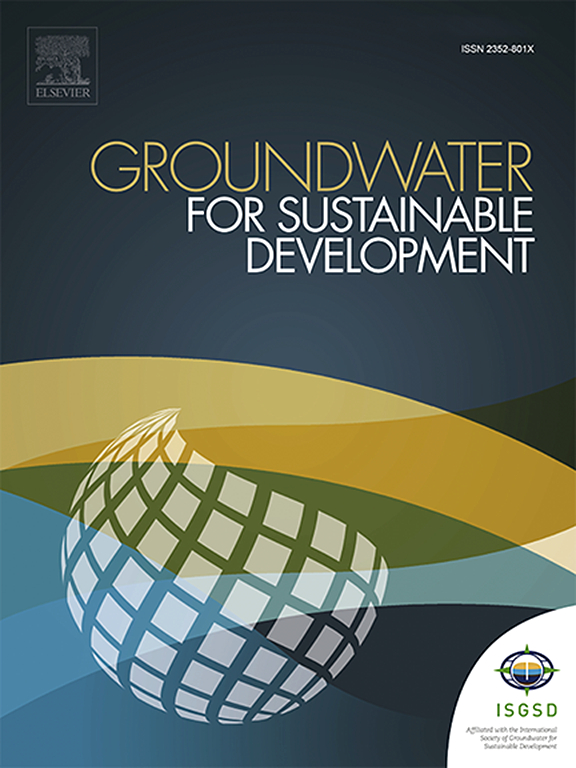Unraveling two-dimensional modeling of multispecies reactive transport in porous media with variable dispersivity
IF 4.9
Q2 ENGINEERING, ENVIRONMENTAL
引用次数: 0
Abstract
The movement of reactive contaminants in subsurface has led to variations in groundwater quality, particularly near chemical and nuclear repositories because of the geochemical and hydrodynamic processes involved in porous media. This study deals with the two-dimensional numerical model to address multispecies transport through saturated porous media with steady-state flow conditions, considering advection, longitudinal and transverse dispersion with the first-order decay and the same is validated with the analytical solution. Focusing on four-species radionuclide decay, this study explores three dispersion models considering constant (ADC), linear (ADL) and exponential distance-dependent dispersivities (ADED) and their comparative analysis reveals the plume mobility emphasizing the role of dispersivity in shaping reactive solute transport by incorporating effective dispersivity. The results show that the concentrations of all radionuclides exhibit their peak values within the source area at time of 500 years, in which 226Ra has the largest plume and a discernible decrease of 12% and 20% is observed in the first moment for ADL and ADED as compared to ADC. Also, the relative plume size is in the order of 226Ra > 238Pu > 234U > 230Th stipulating that the daughter species with largest plume may not necessarily dominate migration. Further, the spatial moments are used to encapsulate the sensitivity analysis, extending the applicability to simulate reactive transport scenarios. This study enhances the ability to predict and understand the long-term environmental perturbations by developing methodologies for modeling and forecasting the contaminants behavior that contributes to SDG-6 and SDG-13 through sustainable groundwater management.

变分散度多孔介质中多组分反应输运的二维解析模型
由于多孔介质中涉及的地球化学和流体动力学过程,地下活性污染物的运动导致地下水质量的变化,特别是在化学和核储存库附近。本文建立了考虑平流、纵向和横向色散及一阶衰减的饱和多孔介质稳态流动条件下多组分输运的二维数值模型,并对解析解进行了验证。本研究以四种放射性核素衰变为研究对象,探讨了考虑常数(ADC)、线性(ADL)和指数距离相关色散(ded)的三种色散模型,并通过对比分析揭示了通过纳入有效色散,强调色散在形成反应性溶质输运中的作用的羽流迁移。结果表明,所有放射性核素的浓度在500年的时间内在源区内出现峰值,其中226Ra的羽流最大,ADL和ADED在第一瞬间与ADC相比分别下降了12%和20%。相对羽流大小为226Ra >;238聚氨酯比;234 u的在230 .规定羽流最大的子种不一定在迁徙中占主导地位。此外,空间矩用于封装灵敏度分析,扩展了模拟反应传输场景的适用性。本研究通过开发模拟和预测污染物行为的方法,提高了预测和理解长期环境扰动的能力,这些污染物行为有助于通过可持续地下水管理实现可持续发展目标6和可持续发展目标13。
本文章由计算机程序翻译,如有差异,请以英文原文为准。
求助全文
约1分钟内获得全文
求助全文
来源期刊

Groundwater for Sustainable Development
Social Sciences-Geography, Planning and Development
CiteScore
11.50
自引率
10.20%
发文量
152
期刊介绍:
Groundwater for Sustainable Development is directed to different stakeholders and professionals, including government and non-governmental organizations, international funding agencies, universities, public water institutions, public health and other public/private sector professionals, and other relevant institutions. It is aimed at professionals, academics and students in the fields of disciplines such as: groundwater and its connection to surface hydrology and environment, soil sciences, engineering, ecology, microbiology, atmospheric sciences, analytical chemistry, hydro-engineering, water technology, environmental ethics, economics, public health, policy, as well as social sciences, legal disciplines, or any other area connected with water issues. The objectives of this journal are to facilitate: • The improvement of effective and sustainable management of water resources across the globe. • The improvement of human access to groundwater resources in adequate quantity and good quality. • The meeting of the increasing demand for drinking and irrigation water needed for food security to contribute to a social and economically sound human development. • The creation of a global inter- and multidisciplinary platform and forum to improve our understanding of groundwater resources and to advocate their effective and sustainable management and protection against contamination. • Interdisciplinary information exchange and to stimulate scientific research in the fields of groundwater related sciences and social and health sciences required to achieve the United Nations Millennium Development Goals for sustainable development.
 求助内容:
求助内容: 应助结果提醒方式:
应助结果提醒方式:


